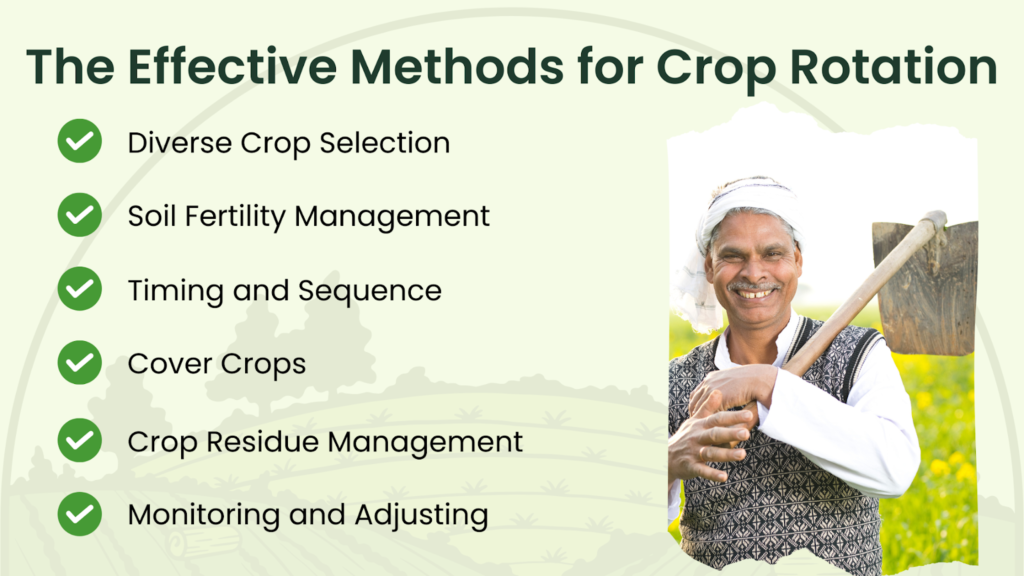
Gone are the days when farming solely relied on chemical solutions; now, we’re revisiting one of the oldest yet most effective agricultural practices: crop rotation.
Crop rotation is not just shuffling crops but a strategic method to boost soil health, increase yields, and sustain farming ecologically. Think of crop rotation as nature’s nutrient management system—a way to keep the soil rich and fertile without relying heavily on artificial means.
But what exactly is crop rotation, and how does it work wonders for soil health?
It involves alternating different crops in the same field across seasons or years. This isn’t a new concept; it’s as old as agriculture. However, with modern farming techniques, it’s taking a back seat for its incredible benefits.
By rotating crops, we do much more than just change what grows where. We’re essentially managing soil nutrients and structure naturally and sustainably. Different crops have varying nutrient needs and contributions, and by alternating them, we ensure that the soil gets what it needs and when it needs it. This approach also helps manage soil organic matter and maximize natural resources.
From legumes that fix nitrogen in the soil to cover crops that conserve vital nutrients for the next planting, crop rotation is an art as much as a science. It’s a dance of give and take between the soil and the crops, benefiting the land and the farmers.
In this blog is your go-to resource for understanding how crop rotation can revolutionize your farming practices and soil health.
What is Crop Rotation?
Crop rotation is a strategic agricultural practice where different crops are grown in a specific order on the same land. This approach contrasts with monocropping, where the same crop is grown repeatedly on the same plot.
The essence of crop rotation lies in its varied planting, ranging from simple rotations of two or three crops to more complex systems involving a dozen or more different crops. The typical crop rotation cycle can span up to eight years, encompassing a diverse range of plants interacting uniquely with the soil.
Why is Crop Rotation Important?

- Enhances Soil Fertility: Different crops contribute and utilize soil nutrients in varied ways. For example, legumes add nitrogen to the soil, benefiting subsequent nitrogen-consuming crops like sugar cane.
- Reduces Pests and Diseases: Regularly changing the type of crops planted disrupts the life cycles of pests and diseases, reducing their prevalence without excessive chemical use.
- Improves Soil Structure: The diversity of root systems and crop residues enhances soil aggregation, crucial for water retention, aeration, and overall soil health.
- Promotes Biodiversity: Different crops support various soil organisms, increasing microbial diversity, essential for a healthy soil ecosystem.
- Efficient Nutrient Management: Crop rotation helps balance soil nutrients, preventing the depletion of essential elements through continuous cropping.
- Supports Long-Term Sustainability: By maintaining soil health and reducing reliance on chemical inputs, crop rotation supports sustainable farming practices beneficial for long-term agricultural productivity.
- Integrates with Livestock Farming: Some crop rotations include periods where no crops are planted, during which livestock grazing can improve soil organic matter and water-holding capacity.
- Increases Crop Yields: Research indicates that certain crop sequences, like following legumes with wheat, can lead to higher yields in the subsequent crops.
Crop rotation is a time-tested, ecologically sound practice crucial in maintaining soil health, boosting crop yields, and promoting sustainable agriculture.
The Benefits of Crop Rotation

Crop rotation is a cornerstone of sustainable agriculture, offering a multitude of benefits for both the environment and farm productivity. This practice involves strategically alternating different crops in a field over various seasons or years. Here’s a closer look at its key advantages:
- Enhanced Soil Fertility
Crop rotation enhances soil fertility by diversifying crop types. Different crops have varying nutrient requirements and release different nutrients into the soil. For example, legumes can fix nitrogen, a crucial nutrient, enriching the soil for future crops that may be more demanding in nitrogen.
This rotation balances soil nutrients and boosts organic matter levels, leading to more fertile and productive soil over time.
- Improved Soil Structure
Crop rotation positively impacts soil structure. Different crops have varying root systems and contribute differently to soil bio-pore distribution. This variation helps break up soil compaction, allowing better water infiltration and root penetration.
Additionally, the diverse microbial activity encouraged by different plant residues improves soil aggregation. This improved soil structure is vital for seed germination, root growth, and overall soil health, making the land more productive and resilient.
- Prevention of Soil Erosion
Crop rotation, particularly with high-residue crops like cereals and grasses, creates a protective layer over the soil. This residue acts as a shield against water and wind erosion. The roots of these crops also help stabilize the soil, reducing the risk of washing or blowing away topsoil.
- Increased Crop Yield
Plants less susceptible to diseases and pests common to a single crop are grown by rotating crops. Healthier, more resilient plants result from this practice, increasing crop yields. This diversity also prevents the overuse of specific soil nutrients, maintaining a balanced and productive soil environment.
- Regulated Soil Nutrient
Including legumes and deep-rooted plants in crop rotation improves soil health. Legumes fix atmospheric nitrogen, enriching the soil for subsequent crops. Deep-rooted plants, on the other hand, reach nutrients deep in the soil, bringing them to the surface and making them available for future crops. This process ensures a more efficient and sustainable use of soil nutrients.
- Pest and Disease Control
Crop rotation breaks the life cycles of crop-specific pests and diseases. By regularly changing crops, pests and diseases lose their primary host, reducing their numbers and spread. This reduces reliance on chemical pesticides, promoting a healthier, more natural farming environment.
- Improved Weed Management
Different crops create different growing conditions, making it harder for weeds to adapt and thrive. This method naturally suppresses weed populations, thus significantly aiding integrated weed management strategies and reducing herbicide dependence.
- Efficient Water Use
Crop rotation increases the soil’s organic matter content, enhancing its water-holding capacity. This leads to better moisture retention in the soil, improving drought resistance, and reducing the need for frequent irrigation. This efficient water use is particularly beneficial in areas with limited water resources.
Overall, crop rotation is an effective strategy for achieving long-term soil health and agricultural productivity, playing a critical role in the sustainability of farming practices.
The Effective Methods for Crop Rotation

In sustainable agriculture, crop rotation is a vital practice. It’s more than just changing crops; it involves a systematic approach to ensure soil health and crop productivity. Here are some key methods farmers can adopt:
- Diverse Crop Selection
Choose various crops with different nutrient requirements and benefits. This diversity helps balance soil nutrients and break pest and disease cycles.
- Soil Fertility Management
Incorporate legumes or green manures in rotation to enhance soil nitrogen levels. These crops fix nitrogen from the atmosphere, enriching the soil for subsequent crops.
- Timing and Sequence
Plan the rotation sequence carefully. Some crops may need to follow others to take advantage of residual nutrients or to prepare the soil for the next crop.
- Cover Crops
Utilize cover crops like clover or rye in between main crops. They protect the soil from erosion, improve soil structure, and add organic matter.
- Crop Residue Management
Manage crop residues effectively by leaving them as a protective layer or composting them later.
- Monitoring and Adjusting
Regularly monitor soil health and crop performance. Be flexible to adjust the rotation plan as needed based on soil conditions and crop responses.
Each method is crucial in a successful crop rotation strategy, leading to healthier soil and more productive farms.
Join Farmini and Transform your Farming Practices Today!

Discover the transformative power of knowledge in agriculture with Farmini. Our platform offers various educational resources to empower farmers with the latest techniques and insights for a more productive and sustainable farming experience.
Dive into our extensive range of courses, learn from industry experts, and apply practical, actionable insights to your farming practices. Embrace innovation and elevate your farming skills with Farmini. Join us today and unlock your full potential as a modern farmer.
Visit Farmini to start your journey towards agricultural excellence.
